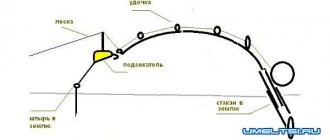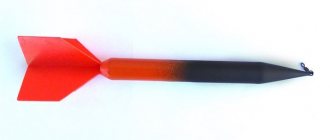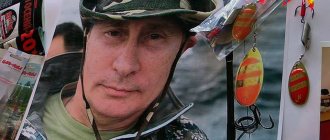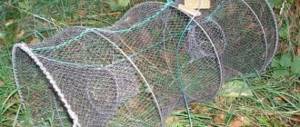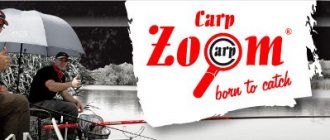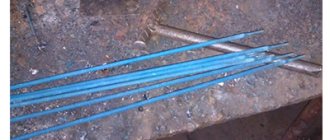Donka is a type of tackle that requires careful selection of the fishing location, weighing such factors as:
- depth of the reservoir;
- assessment of the fishing spot: open or with snags;
- current or standing water.
In rivers, you can catch ruffe, perch, gudgeon, bream and other types of fish using bottom tackle. In a body of standing water (stakes, lakes) you can also hunt for: crucian carp, carp, grass carp and others.
How to make a donka?
Making a donka with your own hands is very simple.
To do this you need:
- Buy a skein of fishing line (100 meters), a set of hooks, and a weight. The numbering of hooks is determined by the type of fish that will be caught.
- If the desired prey is small fish, you need to purchase small hooks (from 2.5 to 5 mm). In case of catching a large specimen, you need to get large hooks (from 6 mm).
- The load must correspond to the given body of water, its weight is determined based on these considerations. Bottom tackle is often used by fishermen to catch various types of fish.
Now let’s look at the advantages of donks over other types of equipment:
- use of donks at great depths;
- combining fishing with feeding fish;
- performing long-distance bait casting;
- fishing on the current;
- using a bite alarm.
Bottom tackle options
Donka is a tackle that is designed for catching fish in most cases from the bottom of a reservoir.
We will look at the most famous bottom gear:
- donka-trashka;
- Donka-elastic band (our grandfathers used this tackle and passed on the knowledge to the current generation).
- feeder equipment (a modern sport type of fishing);
- donka with a spinning rod feeder;
- winter jig fishing.
The option for fishing with bottom equipment is selected in accordance with the type of fish that the angler prefers.
When catching peaceful fish: crucian carp, carp or river fish: roach, bream, the fisherman gives preference to such bottom equipment as: bait, rubber bottom, feeder bottom tackle.
For those who want to hunt predators, there is a bottom rig using circles.
The role of bait is played by live fish (live bait), which attracts the predator.
An analogue of winter equipment for catching predators is the use of girders. Pike, perch, and pike perch fit this definition. These species of predators are deep-sea predators, and bottom rigs will be the right choice when catching them.
The choice of bottom tackle is naturally determined depending on their preferences and interests.
There are fans of both sport and non-sports fishing, but the chosen tackle should bring pleasure and luck will undoubtedly be on your side.
Donka from a spinning rod
Using a spinning rod, you can assemble with your own hands a tackle suitable for catching peaceful fish. It is called bottom tackle or simply donka. It is used for fishing from the bottom of a reservoir due to the large weight of the load and bait with which it is equipped.
Installing a donkey from a spinning rod is a simple process. If you do everything accurately and correctly, it will take no more than 20 minutes. First you need to remove all the elements of the equipment and leave only “clean” fishing line. Next, depending on the type of donkey, new gear is installed. With certain skills, it is even interesting to assemble different types of donks from a spinning rod with your own hands.
fishing line
Good fishing line is the key to success and equipment integrity. Depending on what fish you are going to use the bottom tackle for, you need to choose the diameter and thickness of the fishing line. But for safety and reliability, it is recommended to equip the donk with fishing line with a diameter of 0.4 mm. This thickness is quite suitable for large trophies, and would be an excellent option for use on a bottom rod.
Leash
An integral part of bottom gear. The leash for the donkey should be used with a low breaking load of the fishing line, which will help maintain its integrity even in a situation where a very large trophy is on the hook. The length of the leash should be no more than 10-20 cm. However, this condition may be violated if the tackle is used for fishing with live bait - in this situation the dimensions may be larger.
Equipment
The elements of a classic donkey are a sinker and 2 sharp hooks. Also added to all this equipment is an anti-twist device and a feeder.
Making a snack
Zakidushka is a type of bottom tackle, which consists of a fishing line with a retractable leash, with hooks attached to it. The quantity of which should be between 1-3 pieces. This is done for convenience in throwing gear.
At the end of the fishing line there is a weight, the weight of which depends on the presence of current in a given body of water. The disadvantage of such equipment is the inconvenience of feeding the fish.
Choose a strong fishing line 0.4 - 0.5 mm. You can also use a nylon line to catch large fish.
Donka is a tackle that requires careful selection of the fishing location, taking into account such factors as the placement of this tackle from the beginning of fishing and throughout the entire fishing. The cast can be re-thrown many times during fishing.
These characteristic differences are good because the fisherman, experimenting with the fishing location, finds a suitable, promising one for himself. If the donk is equipped with an elastic band so that it does not need to be removed after each cast, then the zakidushka is deprived of this.
We assemble the donka with our own hands
- fishing line
Taking into account that fishing with bottom tackle involves catching huge fish, you should use a thick fishing line, the diameter of which is over 0.35 millimeters. This will protect you from catching fish, and you, in turn, will be assured of catching a big trophy.
- Sinker
For bottom fishing, drop-shaped sinkers should be used, the mass of which is 30-100 g. This sinker model guarantees correct casting and practicality throughout the entire fishing. When fishing with a donk in reservoirs/rivers (on the current), a weight weighing 30 grams is enough. As waves arise and increase, the mass of the weight for the donkey can be increased.
- Leash
The choice of leash is strictly individual. The main point to focus your curiosity on: when casting, the leash for the donkey does not have to overlap the main part of the fishing line. For comfortable bottom fishing, most anglers use a leash, the length of which is no more than 20 cm. When fishing with live bait and fishing for large fish, the length of the leash can be increased, but five is definitely individual. Leashes are sold in any fishing shopping center; in the absence of difficulties, they can be purchased for an extremely low price.
- Hooks
In most cases, bottom tackle is used for catching large fish; for this reason, it is recommended to use large hooks for bottom fishing. Many fishermen, especially those who are worried about catches, use a series of hooks or tees, which is considered an absolutely advisable solution, since no one wants to lose a large fish. In addition, one should not lose sight of the fact that the hooks must be of excellent quality (with an acceptable self-hooking effect).
Donka with a spinning feeder
The donka with a spinning feeder came to replace the zakidushka as its analogue, but a more modernized prototype. To use this equipment, no effort is required in throwing the tackle by hand.
This can be achieved using a regular spinning rod 2.1 - 2.7 meters long.
Naturally:
- casting distance increases,
- The radius of impact of the tackle is minimized.
- It should also be noted that the equipment is performed using a spring in which the bait is placed. This brings a positive aspect when using the snap.
The bait can be equipped with various types of flavorings (of plant origin or a bite activator). The main line is used with a diameter of 0.3 - 0.35 mm.
When using an inertia-free reel, you must remember to check the clutch in order to:
- soften fish resistance;
- secure the fishing line if the tackle is cast incorrectly.
The line is wound onto the spool, entirely based on reasonable considerations.
The role of the load is performed by a feeder, which is also equipped with bait for attracting fish.
Depending on the type of feeder, the number of leashes is selected
Sometimes so-called “rocker arms” with two leashes are used so that they do not intertwine with each other or the feeder.
The spinning rod is installed on special stands that clamp it tightly so that the slightest bite is transmitted to the alarm. In this role, you can use a bell, which is attached to the top of the spinning rod and serves as both a visual and audible signal.
Bite alarms for donkeys
Bite alarms are conditioned signals that let the fisherman know that the fish is somehow acting on the bait. Signaling devices are mechanical, light and sound.
Mechanical:
- rod nods (the line causes the end of the rod to oscillate);
- “monkey” (a weight is attached between the ring and the reel, which causes the line to sag. When biting, the line stops sagging and the weight moves);
- swinger (attached to a lever with a weight. When biting, vibrations of the rod are also noticeable).
Light signaling devices are called indicators that make it clear that there is a bite on the donk using light. Such a signaling device is attached to the tip of the rod and gives a light signal when there is a bite. Popular among night fishing enthusiasts.
When bitten, sound alarms emit sound signals. They are also attached to the fishing rod and emit sound signals when the fishing line is pulled, which makes it clear that there is a bite.
Electronic bite alarms
Electronic bite alarms are an additional type of alarms that provide combined bite signals (light and sound). They can be attached to the tip or holder of a fishing rod and, using a special system, warn about a bite on the rod. These alarms are only common among professionals.
Donka-elastic band
The rubber donkey has long been familiar to the most experienced fishermen. Simplicity of structure and catchability unite this tackle.
For production you will need:
- fishing line;
- elastic band (Hungarian), which is attached to the fishing line;
- winding rings or swivels with carabiners.
Leashes with hooks in the amount of 5-7 pieces are placed on the fishing line. The numbering of hooks depends on the intended catch and the type of fish that the angler is counting on.
When choosing a 0.3 mm fishing line, the dimensions of the leads should be in the range from 0.16 to 0.2 mm. A weight is placed at the end of the elastic; it is also advisable to use the so-called “reserve”, which is located parallel to the main line to the sinker and plays a duplicate role when removing the bottom.
The bite signal is a bell, but if the bite is effective, fishermen use a regular clothespin or any other available weight. The donka should be equipped with a rope for ease of casting it at a distance.
And ideally, it needs to be launched with a boat, in the presence of which you can also pour out bait instead of placing baited hooks.
Under fishing conditions in still water, floats can be used to raise the active part to a height chosen by the angler.
Donkey bait is used as:
- of live origin (worm, maggot, bloodworm),
- vegetable origin (barley, corn, peas, potatoes).
The difference between donkey and feeder tackle
The difference between donkey and feeder tackle is as follows:
- A feeder is a sporting tackle, when fishing with which it is necessary to timely hook fish, while for donkey this is not necessary. Since it is made using a heavy load, which helps to hook the fish itself.
But at the same time, the use of feeder gear will be more effective. And it’s more interesting to fish with a feeder, constantly casting gear and hooking fish. Donks are more suitable for inactive fishing, when the fisherman is also busy with other types of fishing or simply relaxing on a picnic. - The feeder consists of a fishing rod, which is made of 3-4 components. The donka consists of a telescopic rod, but this is not a prerequisite; it is quite possible to do without it, which is what fishermen often do.
The top can also be of different hardness depending on: the reservoir in which fishing is to be done; on the weight of the fish and a number of other functional features. - Signal of a fish bite: in the feeder, the fisherman notices a bite at the tip of the spinning rod, the rigidity of which is chosen by the angler, as mentioned earlier. In the donk you need to use a bell or other signaling device, which is placed directly on the fishing line.
- Baiting of fish should be done both using a donkey and a feeder. But in any case, this must be done in a timely manner: both before casting gear and throughout the entire fishing trip.
Donka-pipe. Homemade carp
I must admit, this carp drove me crazy! A real scumbag. Time and time again it breaks the feeder line, sometimes with the feeder. It’s clear that the gear is not designed for him, but for the small river roach and not very large bream. And then sometimes you don’t understand whether you accidentally kicked the feeder’s rod, and it jumped up from the impact in the stand. It was such a sharp and short blow. And you start to wind up the braided line and feel a disgusting emptiness on it. No feeder, and, of course, no leash. I also had to catch the rod in flight when it jerked so hard that you didn’t react immediately. And a carp stole a fishing rod from a neighbor who was sitting nearby on the bank of our small river. Okay, a spinner was passing along the shore, and he took out a fishing rod, hooking it with a massive spinner.
And finally my patience ran out when this monster broke my new fly rod, designed for catching local sorb. It was not bought for him... In a word, something had to be done. I didn’t have any gear for carp fishing. The feeder is clearly flimsy for a big-lipped thug, although according to the test indicators of 60-90-120, it tends to be more of a medium to a heavy one. It still won't last. Homemade donkey feeders, which I specially made from old spinning rods for a small river, would also hardly have helped. Strong, the crocodile, he will immediately tear Chinese counterfeits to pieces. But since I had a wealth of experience in fishing with various donks and hooks, a simple idea came to me. You don’t need expensive rods for carp fishing, where should you cast them? The river is as wide as a sheep sneezed, although it is deep. And I decided to make special donks for carp.
I decided to start by choosing a reel. Since casting baits on a small river is inconvenient due to the overgrown banks, I chose a smooth PVC tube as a kind of inertia-free reel. I cut several pieces of it 17 cm long and wound each with a strong new monofilament line 0.4 mm thick. Can't put it any thicker. The fishing line will begin to turn into a spring, and when released it will become overwhelmed. I attached bottom rigs from spring feeders with rocker arms to the fishing line. That's it, the gear is ready. Simple, like the brute homespun truth... True, they cast by hand, but the line is thrown off as if from a spinning spool. He pointed the tube towards the river, swung the rig and - rrrr!.. Threw it away. Anyway, long casting is not required here.
And now the morning of the test. If only he took the bait, otherwise, according to the law of meanness, he will bypass my powerful donks and continue to break my fishing rods. Sly, beast! To lure the thick-lipped fish, I put several red maggots and Bonduelle corn kernels on the hooks. For some reason, this bait, designed for bream, was chosen by carp. The baits turned out to be voluminous, the bream was too tough for them.
A-ha! Strike!.. The feeder bell screamed. The fishing line, not very fastened to the top of the willow rod, fell down from the jerk and became tense, then began to slowly unwind the tube mounted on the base of the rod, with tension, as if from a friction clutch. Let him hold on for now and see if he runs out of steam. Of course... It will fizzle out... It jerked so hard that it almost pulled the rod out of the sand. I had to grab the tackle and fish out the fish. My hands, of course, were cut by the fishing line, but I intercepted it when the jerks subsided and immediately reeled it around the tube.
And finally, a carp fights on the sand. Uh, yes, this is probably the younger brother of that scumbag. I thought it was about ten kilos, but here it was four, probably no more. But this is also a success. The main thing is that the gear works. I will now wait for my older brother...
Alexander Tokarev
I recommend to read:
4 ways to illuminate a quivertip when fishing at night
Which spinning rod to choose
Repairing a delaminated feeder quivertype
Share with your friends!
Sports tackle versus non-sports tackle
The choice between sport and non-sport fishing must be made by the fisherman based on his beliefs and desires.
The sport type of fishing refers to the active type, and the non-sport type does not require much participation and patience in the implementation of hooking when fishing. Only catching fish remains equally interesting and intriguing.
The sport of fishing requires active participation, and, of course, largely depends on his skills and experience.
The sports type of fishing with bottom equipment includes:
- use of spinning rod
- rods
- feeder
- sneak peeks
- winter types of jig fishing.
Non-sports fishing includes:
- spontaneous hooking of fish when using a certain type of gear (not much depends on the skill of the fisherman in general)
- using a hook when landing fish
- bite when swallowing hooks without bait (the fish smelling the aroma of the bait located in the spring swallows it along with the hooks).
In most cases, non-sports fishing is more effective in terms of the number of fish caught. Although with experience and good skills, an angler who prefers sport fishing will not yield and even surpass his opponent.
Choosing a sport fishing method
Choosing a sport fishing method is not an easy task for a young fisherman, since the variety is very large.
Let's consider the main ones:
- Fishing with a fishing rod using an inertia-free reel makes it possible to make long casts, which is an advantage in this type of fishing (the depth and location of the reservoir is chosen by the angler, which gives preference over other types of fishing).
- Fishing with a feeder allows you to throw bait and, at the same time, tackle with bait into the chosen place. Re-casting must be done every 5 minutes due to the washing out of the porridge located in the feeder spring.
- This also includes the sporting method of catching predatory fish: fishing with circles that are equipped with floats to signal a bite. With this gear, live bait is used, the role of which is to attract predatory fish. The circles are placed on the water, and their number is determined by the fisherman.
- Fly fishing is fished by fishermen using artificial insects , which, gliding through the water, create an imitation of a floating fly and thereby attract fish such as chub, asp, sebel. Fly fishing is done with a long rod from the shore or boat.
- winter jig fishing.
These are the most basic types of sport fishing, and each angler makes his own choice, taking into account his desires and aspirations.
From the shore
When fishing from the shore, it is necessary to use long-range gear using:
- inertia-free reels,
- long rods.
Of course, when fishing from the shore, not all possible catching places are open to the angler, as when using a boat, but the advantage is solid ground underfoot with the opportunity to rest and stretch out to your full height, which is rarely possible when using a boat, whenever you would like.
From the boat
Bottom fishing from a boat has a number of advantages over fishing from the shore:
- Characteristic features are the use of small rods, due to the fact that there is no need for long-distance casting of the gear.
- Based on these considerations, it is easier and more accurate to deliver bait to the intended fishing spot.
- When fishing from a boat, the possibility of casting opens up: under the reeds, into holes and into those places from where it is problematic to cast tackle from the shore.
Fishing rods on a boat are installed on special strips with holes made in them and fixed. The bar should be inclined for ease of installation of fishing rods.
It is not recommended to place tackle or a fishing rod on board the boat without fastening.
Due to the fact that if there is a bite or the slightest careless movement of the fisherman, the gear will be lost in the water.
The boat is secured with pegs attached to the bottom of the reservoir and to the boat, respectively. The bow and stern of the boat are secured to ensure its stability on the water.
If the depth is large enough, then you can use 2 anchors attached to the boat.
When fishing with bottom tackle from a boat, the line indicator is not used.
You can notice the bite using rubber tubes that are installed behind the top of the rod and the fishing line is threaded through them.
Experienced fishermen notice and recognize a bite while holding the rod in their hand. When fishing with a bottom rod from a boat using live bait, you can use a scheme with a sliding weight, with pop-up and underwater floats.

